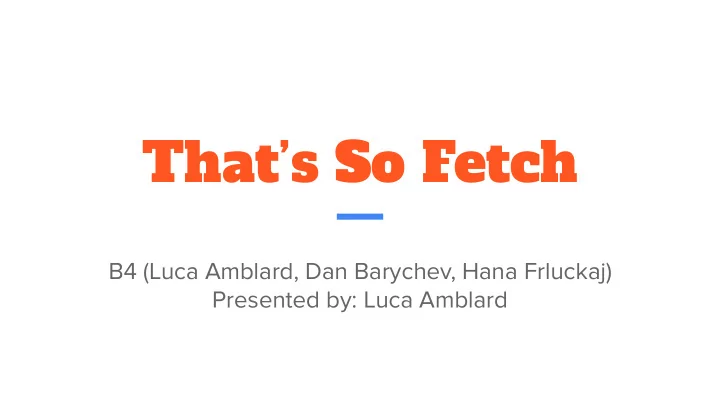

That’s So Fetch B4 (Luca Amblard, Dan Barychev, Hana Frluckaj) Presented by: Luca Amblard
Application Area ● Motorized device that can: Anticipate user’s throw using motion ○ sensors on hand Move to predicted landing location in ○ real time Catch the object thrown ○ ○ Returns to original position Users: ● ○ People allergic to dogs but still want to play a game of Fetch ○ Fun alternative to having a pet
Solution Approach: General Detect ball Determine Simulate Photon reads Prediction IMU data release throw data Fetch Photon reads Detect when ball Determine Vx, Vy, Predict ball Simulate the finger IMU and Vz, throw height, throw/catch is thrown from landing location hand IMU data and horizontal process after data hand through and time of flight through I2C angle of ball at is fed into the finger IMU angular using equations of throw using simulation velocity motion in 3D and Madgwick’s AHRS measure actual sensor fusion algorithm landing location in real life grid
Solution Approach: Changes Simulation based design: Changes due to COVID-19 constraints: ● No physical robot for retrieval → move to ○ simulation based motorized retriever Simulate Fetch using inputs and timing ○ Actual L ● Changes due to current testing constraints: ○ Wireless capability too slow → serial output Robot recording through micro-usb used instead ○ IMU sensing misinterprets fast throws → robot Predict L catching range decreased to 1m ● Changes due to Design Improvement: ○ Kalman filter solutions resulted in too much drift with our sample rate of 50Hz. ○ Switch made to AHRS for accuracy
Block Diagram
Solution - Simulation The simulation presents two views of the project: Bird’s Eye View ➡ View of robot moving in order to retrieve ball Side View View showing the ball’s trajectory and how far up/back the robot must move to retrieve it
Metrics and Validation Process Specs Success Rate (#balls thrown v. #balls caught) > 50% User throw range (distance between user and dog) 1m radius Device retrieval range 1m radius Device basket diameter 25cm Difference predicted ball landing position and actual landing position < 12.5 cm Minimum prethrow number 20 AHRS computation time < 0.5s
Metrics and Validation: Results ● Our tests focused on the system’s ability to create accurate estimates upon a straight line ● We currently have a ~50% catch rate with our most reliable data ● These are the results of two straight throws of around 1m length
Metrics and Validation: Results Cont. ● Madgwick AHRS Algorithm gives us clear parabolic throw data Our throws conform to the type of cyclic motion the algorithm handles well ● ● 95% of our data files process the results in under 0.5s (allowing the simulated robot enough time to make the catch)
Metrics and Validation: Trade-ofgs ● Kalman v. Madgwick’s AHRS ○ Kalman filter: best between 512Hz and 30kHz, but exhibited far too much drift at 50Hz ○ Madgwick’s AHRS filter: uses gradient descent and quaternions to give rotation data, allowing for integrable acceleration data Wireless v. Serial ● ○ Able to achieve wireless functionality with Particle Photon but data transmission rate was too slow. Instead, relied on long micro-USB cable for serial communication to have free movement ● IMU in ball v. IMU on hand ○ IMU in the ball would give information concerning the ball’s path. This would be hard to estimate with IMU positioning so we decided just to place one on the hand instead ● Cornhole bag v. hacky sack Decided to use a cornhole bag since it rarely bounces, although a hacky sack is much easier to ○ throw and restricts arm motion much less
Validation - IMU data and Simulation How to verify IMU data How to verify a simulation ● IMU provides height object is thrown at, as ● Difficult to take all variables into account: well as velocity and angles in three air resistance, object weight, etc. dimensions ● Ball will be thrown and ideally land within ● These data points can be roughly checked the bounds of a measured grid through recorded video ● The actual landing location will be ● Madgwick’s AHRS algorithm prefers cyclic compared to the result of the simulation motion since mean position and velocity ● Accuracy goal: >50% are 0 ● Deviations from this in the throw pattern lead to angle and position errors that we correct for using trigonometry
Project Management
Recommend
More recommend